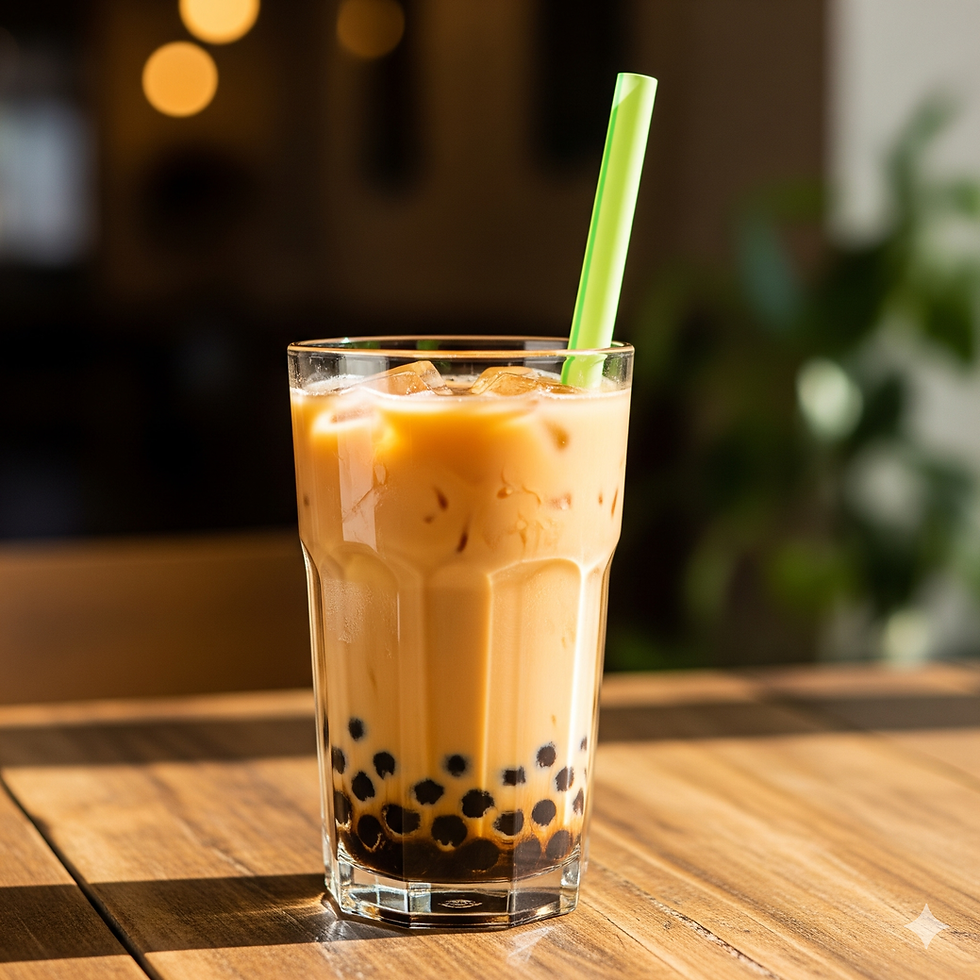A Beginner's Guide to the Chewy, Wonderful World of Boba
- Anonymous
- Sep 26
- 3 min read

You’ve seen them everywhere: the brightly lit storefronts, the lines of eager customers, and the iconic sealed plastic cups filled with milky liquid and a mysterious layer of dark spheres at the bottom. It’s boba tea, and it has taken the world by storm.
But if you’ve never tried it, you might be wondering: What exactly is boba? Is it the pearls? The drink? And what’s the deal with that giant straw?
Here is a complete guide to understanding this delightful and customizable beverage.
The Anatomy of a Boba Tea
At its heart, boba tea (also known as bubble tea or pearl milk tea) is a drink composed of three key parts: the pearls, the liquid base, and the toppings.
1. The Pearls (The "Boba")

This is the defining feature. The classic, dark-colored spheres that settle at the bottom of the cup are the "boba." They are chewy tapioca pearls, made from the starch of the cassava root.
Texture: The ideal boba pearl has a unique and highly prized texture known in Taiwan as "QQ," which means chewy, soft, and bouncy. They shouldn't be mushy or hard.
Taste: On their own, tapioca pearls have a very mild flavor. Their magic comes from how they are prepared. They are typically slow-cooked and then steeped in a sweet brown sugar or longan honey syrup, which infuses them with a rich, caramel-like sweetness.
The Name: While the drink is often called "boba tea," the word "boba" (波霸) itself is a Taiwanese slang term that specifically refers to these tapioca pearls.
2. The Liquid Base

While the pearls are the star, the drink itself is the foundation. It traditionally starts with a base of freshly brewed tea, which is shaken with ice, milk, and sweetener to create a frothy, refreshing beverage.
Tea: Common choices include robust black tea (like Assam or Earl Grey), earthy green tea (like jasmine or matcha), or fragrant oolong tea.
Milk: Creamy milk or a non-dairy creamer is added to create the classic "milk tea." Today, most shops offer a huge range of options, including oat milk, almond milk, soy milk, and fresh milk.
Flavorings: Beyond tea, the liquid can be a fruit-based slush, a coffee blend, or a simple flavored milk. Popular flavors include taro, mango, strawberry, and Thai tea.
3. The Customization (Toppings & More)

Boba is all about choice. Beyond the classic tapioca pearls, a vast universe of other toppings and customizations exists:
Popping Boba: Tiny, juice-filled spheres that burst in your mouth with flavors like lychee or mango. They are not made of tapioca.
Jellies: Cubes or star-shaped jellies made from coconut, grass, or ai-yu fig that add a different kind of texture.
Pudding & Foam: Creamy egg pudding, sweet cheese foam, or salted cream can be added for a rich, dessert-like experience.
Sweetness & Ice Levels: Most shops allow you to customize the sweetness (from 0% to 100%) and the amount of ice, giving you complete control over your drink.
The Finish

The cup is then sealed with a thin layer of plastic film. You pierce this seal with a famously wide-angled straw. This special straw is essential—it’s large enough to suck up the chewy tapioca pearls along with the liquid tea for the perfect sip every time. The result is a unique combination of drinking and eating; a smooth, sweet beverage punctuated by the fun, chewy texture of the boba pearls.
In short, boba is more than just a drink. It's a customizable, multi-textured dessert and beverage rolled into one. It’s a treat, a pick-me-up, and a social phenomenon that invites you to find your perfect combination. So next time you see one of those iconic cups, you'll know exactly what deliciousness lies inside.




Comments